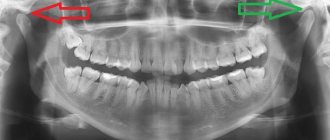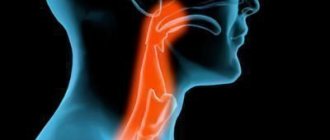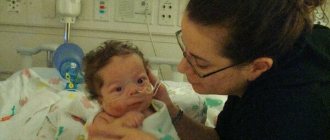Cotard's syndrome is a delusional-hallucinatory disorder that accompanies a person in some studied mental states. Cotard's syndrome does not occur every day in psychiatry, but its danger is too great not to study it in detail. This psycho-manifestation always symbolizes a serious brain problem that exhibits dangerous manifestations in the individual.
Such hallucinatory syndromes belong to perceptual disorders with secondary delusions, which means that hallucinations are formed due to internal brain reasons. But delusional aspects explain hallucinatory manifestations to the character; this is a kind of mental protection.
Clinical picture
Despite the fact that manifestations of K. s. are observed with various nosoles. forms, it has a number of common features both in symptomatology and in the features of its development. It can always identify intense affective disorders, which are characterized by either depression with severe anxiety or depression with fear. A common disorder is melancholic depersonalization (see), often in the form of anaesthesia dolorosa psychica, less often in the form of the so-called. loss of mental vision, when patients become unable to imagine familiar faces, furnishings, and past life events, accompanied by a painful feeling of mental emptiness. Depression in K. s. always combined with agitation of various degrees - from simple wringing of the fingers to states of frantic motor excitement, including in the form of melancholic raptus (frantically melancholy excitement with a feeling of despair). Agitation is often accompanied by speech excitation, usually in the form of anxious verbalization (see Depressive syndromes). At the height of motor excitation, episodes of depressive substupor or stupor may occur (see Stuporous states). Thus, with K. s., as a rule, mixed states of various manifestations are noted, which are “the preferred affective background on which K. s. arises.” Sensory disorders are most often represented by verbal illusions (see), often in the form of illusory hallucinosis, less often auditory hallucinations and mental automatisms, primarily ideational - mentism (involuntary rapid flow of thoughts, accompanied by figurative ideas and a feeling of vague anxiety), unwinding of memories, auditory and visual pseudohallucinations (see Kandinsky-Clerambault syndrome). In some cases, with K. s. clouding of consciousness occurs, usually in the form of oneiroid (see Oneiric syndrome).
Against the background of the listed disorders, fantastic delusions arise, the main signs of which are denial and enormity. Denials can be partial, most often relating to moral, intellectual or physical. properties of the patient (“no feelings, conscience, compassion, knowledge, ability to think; no stomach, intestines, lungs, heart, bladder”), or they may speak not about the absence, but about the destruction of internal organs (“the brain has dried out, the lungs have shrunk, the intestines are clogged"). Ideas of denial concerning the physical self are usually defined as hypochondriacal-nihilistic or simply nihilistic delusions. In a number of cases, personal categories are denied (“no name, age, education, profession, family, never lived”). Denial can be generalized, extending to various concepts of the external world, which may be dead, destroyed, lose their inherent qualities, or be absent altogether (“the whole world is dead, the planet has cooled down, nothing grows on it, there is no one in the world, there are no whites, black, Europe, Africa, winter, spring, stars, years, centuries"). The patient may believe that he is alone in the entire universe and may deny the existence of everything (“there is nothing”).
Along with the delusions of denial and enormity, it is often possible to identify delusions of self-blame that are fantastic in content (patients consider themselves to be the root cause of the world cataclysms that have occurred; attribute incredible crimes to themselves; call themselves monsters, reptiles, monsters; often correlate their actions with those committed by mythical or historical characters, they call themselves the Antichrist, Cain, Judas, Hitler; they talk about deserved punishments, sometimes listing the most incredible ways of paying for their deeds). In a number of cases, the fantastic delirium of self-accusation takes on a retrospective character. At the same time, patients can talk about impending eternal torment or the impossibility of dying, either in general or as a well-deserved retribution. The inability to die and eternal torment, according to patients, can be realized even when their physical self disappears - “the body will be burned, but the spirit will remain forever - tormented.”
It is possible to combine the ideas of immortality with the delirium of metamorphosis - transformation into an animal, into a corpse, into metal, wood or stone. A distinctive feature of delusional statements of patients with K. s. is the presence in them of distinct elements of imagery and clarity. Often patients themselves pay attention to this (“every spoken word grows in the mind into something big; fantasy turns a fact into a whole story; imagination draws entire scenes, a word grows into a thousand words and a picture appears”). The peculiarities of the delusion of self-blame and its verbal expression gave rise to such synonyms of KS as “megalomelancholic delirium,” “melancholic paraphrenia,” and “melancholic delirium of the imagination.”
The combination of delirium of denial and the enormity of hypochondriacal-nihilistic and depressive content characterizes the full or expanded K. s. If any one of these components predominates, they speak of the corresponding variants of CS—nihilistic or depressive. They occur much more often than expanded K. s. In addition to these two options, there are types of K. s., based both on symptomatology and on the characteristics of the course of K. s. Segla (JE Seglas, 1897) identified: 1) typical cases, that is, those in which all the components of K. were present; 2) erased cases - with the absence of a number of symptoms, for example, ideas of doom to eternal torment, ideas of immortality, etc.; 3) cases with a very rapid appearance of all symptoms forming K. s.; 4) cases with similar development of only part of the symptoms; 5) cases where the symptoms that form K. pages occur in the form of episodes.
The most characteristic stereotype of the development of depression, during which K. develops. (regardless of their nosole, affiliation and characteristics of the course - paroxysmal or chronic), the following sequence of occurrence of stages of mental disorders is the following: the stage of anxious depression without ideomotor inhibition; stage of anxious-agitated depression with delusional ideas of self-blame, self-humiliation, accusations, melancholic depersonalization, verbal illusions and other sensory disorders; the occurrence of symptoms that together form K. s.
The use of electroconvulsive therapy (see) and especially psychotropic drugs for the treatment of depressive psychoses had a significant impact on the wedge, K.'s manifestations. His detailed paintings began to appear less frequently, and depressive and nihilistic versions of K. s. are more often manifested by reduced symptoms. Patients talk, for example, about their unusual guilt, but in general, without any specific facts, and also without identifying themselves with anyone; There may be thoughts about the impossibility of dying, but they are not accompanied by the conviction of immortality and doom to eternal torment. Instead of generalized ideas of denial or destruction of internal organs, only statements about the non-functioning of gland.-kish are more common. tract or respiratory organs. In some cases, statements characteristic of K. s. are not nonsense, but obsessive phenomena of fantastic content, with which the patient is trying to fight. If, before the introduction of active therapy methods, the presence of K. s. spoke about hron, depression, now cases that occur in attacks dominate.
Post-hospital support
After discharge from our hospital, the patient’s relatives receive the necessary recommendations. To reduce the likelihood of relapse, they should monitor the emotional state of the patient. No matter how he behaves, it is important to be calm and reasonable with him. If you suspect a relapse, you should immediately consult a doctor. To do this, you don’t have to go to the clinic; you can invite a doctor to your home.
The psychiatrist's recommendations include:
Compliance with diet. You should not feed a person with mental disabilities spicy and fried foods. It is required to strictly exclude alcohol and smoking.- The need to stay in the fresh air as often and as long as possible, especially in nature (in the forest, on reservoirs).
- Creating an atmosphere of kindness, warmth and joy at home.
- Avoiding heavy physical activity and injury.
With all your efforts, you should remember that Cotard's syndrome, unfortunately, is incurable. In order to achieve remission, very serious intervention is required, without which the progression of the disease is inevitable, leading to death.
The most important recommendation of the doctors at the Leto mental health center is to seek help at the very first signs of pathology and strictly follow the doctor’s recommendations.
Treatment
With the development of K. s. First of all, therapy with psychotropic drugs is indicated. Due to the complexity of the wedge, treatment with psychotropic drugs should be combined. Among the antidepressants, amitriptyline is most often used, and melipramine is less commonly used; to relieve speech motor excitation - chlorpromazine, stelazine; anxiety is reduced with tizercin; in the presence of senestopathies, the use of teralen has a good effect. In cases where there is intense speech motor agitation, accompanied by a deterioration in the somatic condition, preference should be given to electroconvulsive therapy.
Symptoms
The most common are nihilistic delusions regarding the body and existence. Other descriptions include:
- denial of reason
- brain,
- intelligence,
- pregnancy denial,
- delirious paralysis.
Find out more 20 famous people with Asperger's syndrome
Nihilistic delusion may also include denial of the existence of various aspects of the body or self, that is, personal space, such as renunciation of life, non-existence of the soul, personal name, age, ability to walk, ability to eat, presence of heart, brain, liver, intestinal function , limbs.
Aspects outside the personal space may include the existence of the world, marriages, parents, children.
Forecast
The prognosis is largely related to the characteristics of the underlying disease and the treatment methods used. The appearance of expanded K. s. or expressed nihilistic delusional ideas regarding recovery are prognostically worse than the presence of a depressive version of K. s. The combination of delusions of denial and enormity with severe speech motor agitation and oneiric clouding of consciousness in the elderly can lead to death if not treated sufficiently.
Prevention
- timely initiation of active therapy in all cases of anxious depression, especially those developing for the first time in old age.
Bibliography:
Kaubish V.K. On the use of electroconvulsive therapy in patients with Cotard's syndrome, Zhurn, neuropath, and psychiat., t. 62, no. 10, p. 1544, 1962; about N, About the delusion of denial and Cotard's syndrome, ibid., vol. 64, No. 6, p. 876, 1964, bibliogr.; Morozova T. N. and Shuisky N. G. Clinic of involutional melancholia and its dependence on the age factor, ibid., t. 66, No. 4, p. 598, 1966, bibliogr.; Rothstein G. A. Hypochondriacal schizophrenia, M., 1961, bibliogr.; Sokolova B.V. Periodic schizophrenia with a predominance of acute fantastic delusions, Zhurn, neuropath, and psychiat., t. 67, no. 9, p. 1378, 1967, bibliogr.; Sternberg E. Ya. and Shum-s to and y N. G. About some forms of depression in old age, in the same place, vol. 59, No. I, p. 1291, 1959; Bourgeois M. Le syndrome de Cotard aujourd'hui, Ann. med.-psychol., t. 2, p. 534, 1969, bibliogr.; Cotard J. Du d61ire hypochondriaque dans une forme grave de la melancolie anxieuse, ibid., ser. 6, t. 4, p. 168, 1880; aka, Du delire des negations, Arch. Neurol. (Paris), t. 4, p. 152, 1882; E y H. Etudes psychiatriques, t. 2, p. 427, P., 1950, bibliogr.; S&gl as J. Le d^lire des negations, P., 1894.
N. G. Shumsky.
Causes of Cotard's syndrome
In order to correctly prescribe treatment, the doctor must understand the factors that caused this disorder. For this purpose, we carry out comprehensive diagnostics and identify the source of the disease.
The most common causes of the disease are:
- Endogenous depression.
- Overdose of certain types of psychotropic drugs, in particular antidepressants.
- Neurotic disorders, constant psycho-emotional overload, stress reactions.
- Traumatic head injuries, neurosurgical interventions.
- Diseases that occur with severe intoxication.
- Epilepsy.
- Schizophrenia.
- Senile forms of dementia.
- Disease processes with metabolic disruptions in the body.
These pathologies lead to dysfunction of the main neural connections and the appearance of typical symptoms of the disease.
The name of the disease was suggested by the name of the French healer who first described this deviation as delusion of denial.
How is psychotic depression diagnosed?
Most diagnostic manuals classify psychotic depression as a subset. However, there is ongoing debate among mental health professionals about whether this definition is accurate.
The International Classification of Diseases (11th edition) considers psychotic depression to be the most severe subtype of depressive disorder. The Diagnostic and Statistical Manual of Mental Disorders, fifth edition (DSM-5), also characterizes psychotic features as a subgroup of depression. However, as we have already said, there is no consensus on the issue yet.
Diagnosis of the condition is also complicated by the fact that depression with psychosis has similar features to some other disorders. Among them, for example, classic depression, schizoaffective disorder and those provoked by external factors. However, if, along with signs of ordinary depression, the doctor records hallucinations and paranoid moods, this is most likely psychotic depression.
Fibrodysplasia ossificans progressive
In this rare and serious disease, a person's muscles, tendons and ligaments gradually turn into bones. As the soft tissue hardens, mobility begins to deteriorate. The hardening process, which begins in childhood, starts from the neck and slowly moves down. As the disease progresses, the soft tissue around the ribs also turns into bone, causing breathing problems. The bone puts pressure on the lungs and it becomes almost impossible to take a deep breath. The person actually turns into a living statue. Patients with FOP usually do not live longer than 40 years.
What is depression with psychosis?
Classic depression
- one of the most common mental health conditions, characterized by poor mood, decreased activity levels, and decreased appetite (both in one direction and the other). Here are a few more symptoms that are characteristic of depression:
- feeling extreme sadness, anger, or irritability;
- loss of interest in once enjoyable activities;
- inability to concentrate;
- recurring thoughts about death.
Psychosis
it means that a person feels disconnected from reality. This occurs when someone regularly experiences things that do not exist - in other words, hallucinations. It is important to remember that psychosis is always a symptom of a condition, but does not exist in itself. Here are the specific symptoms of psychosis:
- false beliefs or misconceptions;
- hallucinations (visual or auditory);
- paranoia.
It is logical to assume that a person with psychotic depression will exhibit symptoms of each condition. Moreover, this can be the entire spectrum of symptoms, or only some of them.
Schizophrenia
Schizophrenia, as a mental disorder, has many formations that can subsequently affect the formation of delusions. In this case, the nature of delirium is entirely related to the mental and somatic disorder of the schizophrenia class. Due to the specific work of neurons in the patient’s head, this happens.
A change in personality and worldview that is caused by alienation associated with distrust of the world around us. It may not be thematic at first (“something happened, something is happening”) and then suddenly or gradually acquire meaning, a theme.
Fatal familial insomnia
This disorder is perhaps the scariest on this list. The disease is caused by a genetic mutation in the PRNP gene, which changes the shape of protein molecules that then collide and form a clump in the part of the brain that controls sleep. The patient begins to experience insomnia, which not only does not go away over time, but progresses. It cannot be stopped or slowed down, and death occurs after 12-16 months. The mutation is inherited, hence the word “familial” in the name.











